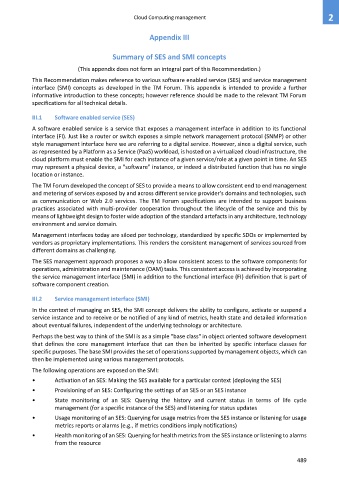Page 497 - Cloud computing: From paradigm to operation
P. 497
Cloud Computing management 2
Appendix III
Summary of SES and SMI concepts
(This appendix does not form an integral part of this Recommendation.)
This Recommendation makes reference to various software enabled service (SES) and service management
interface (SMI) concepts as developed in the TM Forum. This appendix is intended to provide a further
informative introduction to these concepts; however reference should be made to the relevant TM Forum
specifications for all technical details.
III.1 Software enabled service (SES)
A software enabled service is a service that exposes a management interface in addition to its functional
interface (FI). Just like a router or switch exposes a simple network management protocol (SNMP) or other
style management interface here we are referring to a digital service. However, since a digital service, such
as represented by a Platform as a Service (PaaS) workload, is hosted on a virtualized cloud infrastructure, the
cloud platform must enable the SMI for each instance of a given service/role at a given point in time. An SES
may represent a physical device, a "software" instance, or indeed a distributed function that has no single
location or instance.
The TM Forum developed the concept of SES to provide a means to allow consistent end to end management
and metering of services exposed by and across different service provider's domains and technologies, such
as communication or Web 2.0 services. The TM Forum specifications are intended to support business
practices associated with multi-provider cooperation throughout the lifecycle of the service and this by
means of lightweight design to foster wide adoption of the standard artefacts in any architecture, technology
environment and service domain.
Management interfaces today are siloed per technology, standardized by specific SDOs or implemented by
vendors as proprietary implementations. This renders the consistent management of services sourced from
different domains as challenging.
The SES management approach proposes a way to allow consistent access to the software components for
operations, administration and maintenance (OAM) tasks. This consistent access is achieved by incorporating
the service management interface (SMI) in addition to the functional interface (FI) definition that is part of
software component creation.
III.2 Service management interface (SMI)
In the context of managing an SES, the SMI concept delivers the ability to configure, activate or suspend a
service instance and to receive or be notified of any kind of metrics, health state and detailed information
about eventual failures, independent of the underlying technology or architecture.
Perhaps the best way to think of the SMI is as a simple "base class" in object oriented software development
that defines the core management interface that can then be inherited by specific interface classes for
specific purposes. The base SMI provides the set of operations supported by management objects, which can
then be implemented using various management protocols.
The following operations are exposed on the SMI:
• Activation of an SES: Making the SES available for a particular context (deploying the SES)
• Provisioning of an SES: Configuring the settings of an SES or an SES instance
• State monitoring of an SES: Querying the history and current status in terms of life cycle
management (for a specific instance of the SES) and listening for status updates
• Usage monitoring of an SES: Querying for usage metrics from the SES instance or listening for usage
metrics reports or alarms (e.g., if metrics conditions imply notifications)
• Health monitoring of an SES: Querying for health metrics from the SES instance or listening to alarms
from the resource
489

